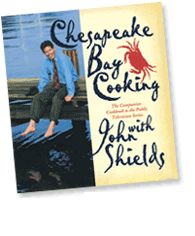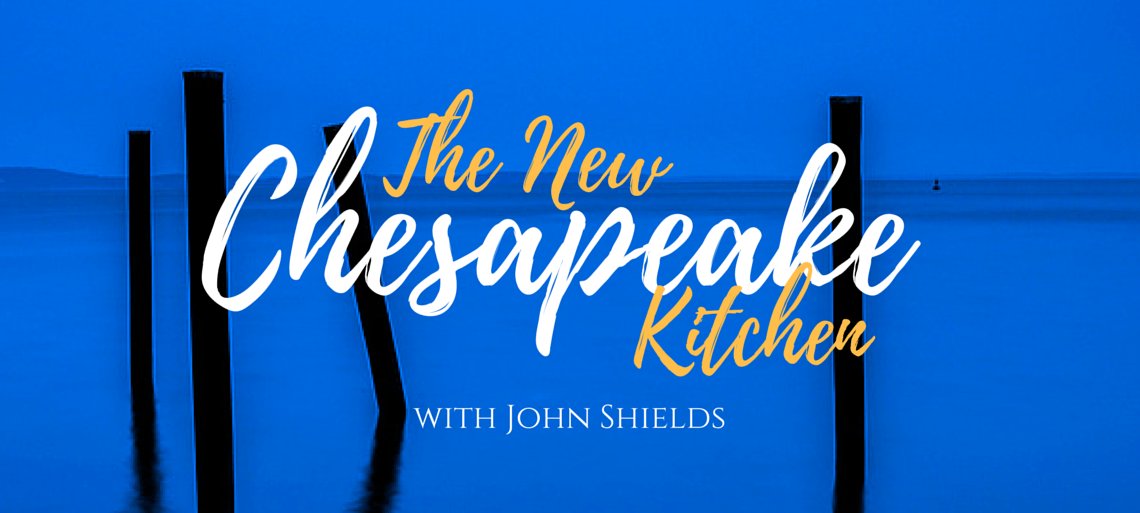The New Chesapeake Kitchen Tour Begins – Coming Soon To A Town Near You

After years of planning, ruminating, procrastinating, and a good bit of day dreaming, the New Chesapeake Kitchen project is underway. The fine folks at Johns Hopkins University Press will be publishing two works by me in the relatively near future: the 25thAnniversary Edition of The Chesapeake Bay Cookbook (aka Chesapeake Bay Cooking with John Shields) in Fall 2015, and a brand new work, The New Chesapeake Kitchen, in Fall 2016.
In the 25th Anniversary Edition I will be updating information, adding back some delicious time-honored recipes that got sidelined between editions, and including a slew of brand new additions, such as a whole new Chesapeake Libations chapter.
The New Chesapeake Kitchen will be imagining a new, local kitchen for the 21stcentury. Things are much different in the Chesapeake region than they were when the native peoples populated the shores, and when Captain John Smith first sailed into the Bay and wrote; “the fish were so thick we attempted to catch them with frying pans.” The types of seafood available and the populations of the native species have changed. The water quality is a challenge, along with a number of other environmental concerns. So how are we to cook in this new century? While there’s some bad news out there, fortunately there’s even more good news, as I’m discovering lots of local folks doing great things to rebuild our food scene and food economy. The New Chesapeake Kitchenwill chronicle this revitalization and hopefully through the tales of locals show us the way to a vibrant culinary future.
The New Chesapeake Bay Kitchen Research Tour kicked off last week in Hampton Roads Virginia: Williamsburg, Norfolk, Virginia Beach, Suffolk County, Portsmouth, and then onto the lower eastern shore of Virginia. It was an amazing week down in the Hampton Roads area and beyond.
Both the Williamsburg Inn and the Department of Historic Foodways of Colonial Williamsburg have their own mini farms and gardens. Chef Brust at the Inn insists that his culinary interns work in the gardens as part of their training. And from this garden and back into the restaurant’s grand Regency Room, the students take an amuse bouche cart tableside and use much of what has been grown in the garden to fashion the these little bites for their guests. It gives the interns, now with an intimate knowledge of the food under their belts, an opportunity to share their passion for this garden’s bounty with guests, as they helped to grow and harvest it. And Chef Travis tells me that it makes for some stimulating dinner conversation.
Over at the center of Revolutionary City some of the best baking in town is actually going on at the wood-burning, mud-covered, outdoor brick oven where Frank Clark prepares scrumptious whole-grain bread. The bread, made from a colonial recipe, is leavened with beer yeast, giving the crusty loaf a rich, earthy flavor. According to Frank, back in the day the average citizen of Colonial Williamsburg would get 50 to 60 percent of their daily calories from this wholesome bread.
Here’s a Johnnycake recipe that can be made in the traditional manner with bacon grease; or in a healthier, contemporary version using vegan butter flavored with Liquid Smoke to retain a smokehouse taste.
Johnnycakes
Serves six to eight
1 egg or 1 ½ teaspoons Ener-G Egg replacer whisked well with 2 tablespoons warm water
1 tablespoon sugar
1 ½ cups milk, or soy milk
½ teaspoon salt
¾ cups yellow cornmeal, stoneground
¼ cup all-purpose flour
1 tablespoons butter, melted (or vegan butter)
3 tablespoons bacon drippings, melted* (vegan butter or vegetable oil may be substituted for this as well. For a very authentic taste, put 2 drops of Liquid Smoke into the melted vegan butter or oil.)
Preheat the oven to 4000F.
Beat the egg and sugar together in a bowl. Stir in the milk and salt. Beat in the cornmeal and flour. Mix in the butter and 2 tablespoons of the bacon drippings.
Generously grease an 8-inch cast-iron skillet with the remaining 2 tablespoons of bacon drippings. Put in the hot oven for about 5 minutes. Wearing oven mittens, remove from the oven and pour in the batter.
Return to the oven and bake for 30 – 40 minutes, or until well browned. Serve hot, cut into wedges.
— Adapted from Chesapeake Bay Cooking with John Shields
Stay tuned for our next stop: Full Quiver Farm in Suffolk and New Earth Farm in Virginia Beach

Be the first to comment.